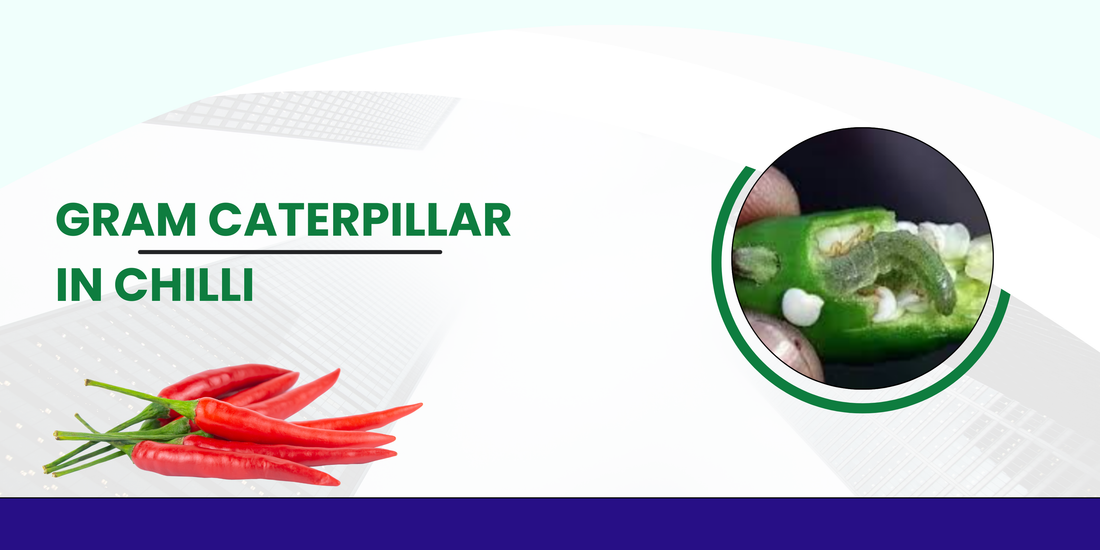
GRAM CATERPILLAR IN CHIILI
Telugu name: Shanaga pacha purugu
Scientific name: Helicoverpa armigera
Identification of pest
- Eggs: Are spherical in shape and creamy white in colour, laid singly
- Larva: Shows colour variation from greenish to brown
- Pupa: Brown in colour, occurs in soil, leaf, pod and crop debris
- Adult: Female is brownish yellow stout moth, Male is light greenish in colour with “V” shaped markings.
Life cycle
- The presence of adults near lights at night and in pheromone traps is a clear indication that it has started.
- Females can lay more than 1,000 eggs. Larvae hatch after three days and initially feed on leaves and flowers. While growing older, the caterpillars prefer to bore into fruiting bodies.
- Larval development takes 2–3 weeks. Pupation normally takes place in the soil and the pupal stage takes two weeks.
SYMPTOMS
- Young larva feeds on the leaves for some time and then attacks buds and fruits.
- Internal tissues are eaten severely and completely hollowed out.
- While feeding, the caterpillar thrusts its head inside leaving the rest of the body outside.
- The bored fruits are found with round holes. Fruit attack has resulted in premature fall.
FAVORABLE CONDITIONS
- The pest prefers hot, dry weather. Temperatures between 25°C and 35°C are ideal for its development.
- Overcrowded Crops can provide a favorable environment for the caterpillar to hide and feed.
Economic Threshold Level (ETL)
Control measures should be initiated if:
- 2-3 larvae per plant and 10-15% of the fruits are damaged.
MANAGEMENT
- Cultural Control
- Collect and destroy the infected fruits and grown up larvae.
- Crop Rotation to break the pest's lifecycle can help reduce its population.
- Setup pheromone trap with Helilure at 15/ha.
- Provide poison bait with carbaryl 1.25 kg, rice bran 12.5 kg, jaggery 1.25 kg and water 7.5 lit/ha or spray any one of the following insecticide.
Biological Control
- Six releases of T. chilonis @ 50,000/ha per week coinciding with flowering time.
- Release Chrysoperla carnea at weekly interval at 50,000 eggs or grubs / ha from 30 DAS.
- Spray carbaryl 50 WP 2 g/lit or B. thuringiensis 2 g/lit.
Chemical Control
- For effective control of Caterpillar in chilli we can use bio pesticide like “LARVEX 250 ml / acre”.
FAQ’S
1. How can we identify gram caterpillar damage in chilli plants?
Look for chewed leaves, holes in fruits, and droppings near damaged areas. Caterpillars often hide during the day and feed at night.
2. Can companion planting help deter gram caterpillars?
Yes, planting marigolds or basil near chillies can repel caterpillars and other pests while improving overall plant health.
3.What are the biological control methods for gram caterpillars?
Six releases of T. chilonis @ 50,000/ha per week coinciding with flowering time.Release Chrysoperla carnea at weekly interval at 50,000 eggs or grubs / ha from 30 DAS.
4.What is the chemical control method for gram caterpillar?
For effective control of Caterpillar in chilli we can use bio pesticide like “LARVEX 250 ml / acre”.
5.What is the ETL level for gram caterpillar?
2-3 larvae per plant and 10-15% of the fruits are damaged.
